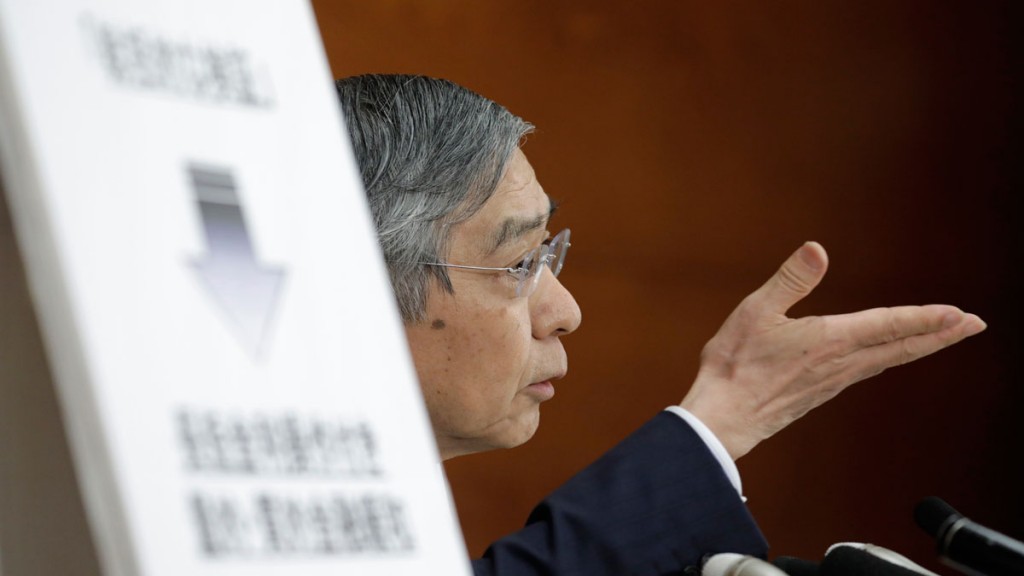
It was the moment that markets had been waiting for all week.
The Bank of Japan’s “comprehensive review”, in which the world would watch as it took the next step down the wacky road of experimental monetary policy.
The whole thing unfolded at 3am this morning, UK time.
So for those who weren’t up at that ungodly hour, what happened?
What the Bank of Japan didn’t do
First off, here’s what didn’t happen.
The Bank of Japan (BoJ) didn’t cut rates any further. It kept the short-term interest rate at -0.1%.
It didn’t announce plans to buy yet another big chunk of bonds – in fact it scrapped its specific ¥80trn target, saying it will now fluctuate (although it did toss another few trillion – ¥2.7trn to be precise – at buying equity market exchange-traded funds).
And it didn’t launch “helicopter money”.
Instead, there were two main takeaways. The first big change is that the BoJ is now targeting a specific interest rate for ten-year bonds. It wants the ten-year yield to hover around the current level of 0%.
What’s the significance of this?
Let’s go back to the start of the year. That’s when the BoJ took interest rates negative. Markets didn’t like that – mainly because it had the knock-on effect of squeezing banks’ profit margins.
So it seems that the BoJ is now focusing on boosting banks’ potential profits. Banks borrow short and lend long (that’s one reason why they are so vulnerable in a crunch – their short-term money dries up and their long-term loans go bad).
So the BoJ wants to “steepen the yield curve”. That’s jargon which means that it wants long-term interest rates to be a good bit higher than short-term ones, because the bigger the gap, the more profitable it is for banks. It also opens the door for taking short-term rates more negative in the future, while keeping the target on the ten-year at 0%.
But, perhaps more pertinently, it also gives the BoJ an excuse to buy fewer bonds and perhaps even sell some at the longer end of the spectrum. Because the reality is that they’re running out of bonds to purchase.
Equity investors certainly bought the BoJ’s story, with the banking sector of the Topix index shooting up by 7% and insurers by 5.5%, all of which helped to boost the overall index.
The yen on the other hand, wasn’t entirely sure what to do – it fell for a bit and then strengthened again.
I will do such things – what they are yet I know not
That wasn’t the only change. The BoJ has also tweaked the way that it talks about its inflation target. It kept the inflation target at 2%. But now it says that it will keep fiddling with monetary policy until, as Capital Economics puts it, inflation “remains above target in a stable manner. In other words, the BoJ pledged to overshoot the target”.
This is the BoJ’s version of when Mario Draghi said he would do “whatever it takes”. In effect, BoJ boss Haruhiko Kuroda is saying that he’ll go hell for leather to get Japanese inflation up, and he’s not going to even think about stopping until inflation has been sitting comfortably above 2% for a good long while.
This is interesting. It’s the sort of promise that would sound quite radical – irresponsible even – coming from the Federal Reserve. Janet Yellen has hinted that she’d like to see inflation “running hot” for a while, but with US inflation positive and not that far off the Fed’s target, she’d never dare say this as explicitly as Kuroda has.
However, this is part of Japan’s problem. While this commitment to overshoot the inflation target might seem threatening coming from another central bank, it’s not quite so effective coming from a country that hasn’t been within sniffing distance of 2% for decades now.
It’s all very well saying that you’re going to throw caution to the winds, but if investors and consumers don’t believe you can do it, they’re not going to change their behaviour or their expectations in the way you want them to.
In short, this wasn’t a bazooka. But it wasn’t nothing either. Support for the banking sector is probably a good sign for Japanese equities – good times for banks tend to mean good times for the stock market in general.
It might disappoint markets – once they’ve got over their initial excitement – that helicopter money wasn’t forthcoming. But perhaps Kuroda isn’t keen to do anything as radical as pure helicopter money yet. For as long as he stalls for time, he’s still got the threat of a big bazooka up his sleeve. But if and when he pulls it out, he’s in trouble – because if it doesn’t work, that’s it.
More to the point, he’s now effectively acknowledged that the BoJ controls the entire bond market. He’s fixed the price at which the Japanese government can borrow for ten years at 0%.
Once upon a time, that would have been considered radical. It shows you far from the old world we’ve come that it might be viewed as an anti-climax.